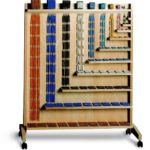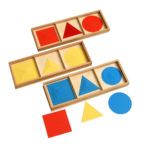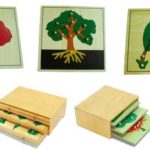Montessori Materials
Montessori classrooms are easily recognizable by the Montessori materials – a concrete and hands-on approach to learning. The children progress from one level of difficulty to the next, gaining confidence and knowledge before learning abstract theories.
A common misconception holds these materials to be teaching aids, tools that will help teachers convey those matters which adults believe children must learn. Their function is, however, of far greater scope. Adults can teach children a limited amount of facts. The knowledge children can acquire if they are free to follow their inner dictates is unlimited. The Montessori educational apparatus is self-directed in that it provides the children with motives for purposeful activity perfectly adapted.
A few material examples:
 Bead Material
Bead Material
This extensive set of bead materials is used for the exercises of linear and skip counting the quantities of the squares and cubes of the numbers 1-10. It prepares the child for later activities in multiplication, squaring and cubing, as well as base number work.
Circle, Square & Triangles
The sets of circles, squares & triangles provide the possibility for the child to explore and experiment with the three basic geometric shapes.
 Botany Puzzles
Botany Puzzles
A set of three wooden Botany Puzzles. One puzzle illustrates the component parts of a plant (tree), one illustrates the leaf and one illustrates the flower.
Subjects are first introduced with multi-sensory, hands-on materials that encourage concrete learning before the child moves on to abstract learning. The cultural subjects are integrated and expansive, to encourage a broad base of learning.



